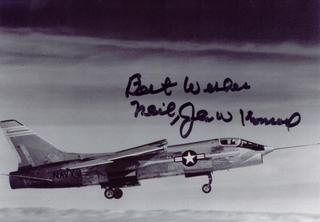

On June 29, 1953, the Navy ordered three prototypes under the designation XF8U-1. Bureau of Aeronautics serial numbers were 138899 through 138901. Only two of these prototypes were actually built, 138901 being cancelled before it could be built.The first prototype (BuNo 138899) was ready for its first flight in February of 1955. It was trucked out to Edwards AFB for its first flight. It took off on its maiden flight on March 25, 1955, Vought chief test pilot John Konrad being at the controls. It went supersonic on its first flight.
 The first flight of the XF8U-3 was made at Edwards Air Force Base on June 2, 1958, with test pilot John Konrad at the controls. The flight lasted 48 minutes and during which the aircraft attained a speed of 350 knots at 20,000 feet. During subsequent flights, the XF8U-3 achieved a speed of Mach 2.39 (approximately 1,601 mph) and was still accelerating at 0.1 Mach every 17 seconds. This was extraordinary even when compared to the performance of today’s aircraft.
The first flight of the XF8U-3 was made at Edwards Air Force Base on June 2, 1958, with test pilot John Konrad at the controls. The flight lasted 48 minutes and during which the aircraft attained a speed of 350 knots at 20,000 feet. During subsequent flights, the XF8U-3 achieved a speed of Mach 2.39 (approximately 1,601 mph) and was still accelerating at 0.1 Mach every 17 seconds. This was extraordinary even when compared to the performance of today’s aircraft. John William Konrad's aviation career spanned 56 years, starting at age 15 in a J-3 Cub in San Diego, CA. He entered the Army Air Corps in 1943 and was assigned to a B-17 combat crew with the 305th Bomber group in Germany during World War II. After the war, he was assigned as a C-47 commander in the Berlin Airlift. He also served as a pilot for the United Nations in Beirut, Lebanon.
John William Konrad's aviation career spanned 56 years, starting at age 15 in a J-3 Cub in San Diego, CA. He entered the Army Air Corps in 1943 and was assigned to a B-17 combat crew with the 305th Bomber group in Germany during World War II. After the war, he was assigned as a C-47 commander in the Berlin Airlift. He also served as a pilot for the United Nations in Beirut, Lebanon.After returning from Europe, he was selected for the first test pilot training school in Dayton, OH. and was subsequently assigned to Muroc Army Airfield, CA., later known as Edwards Air Force Base. During his 4 year assignment at Edwards, he flew 28 different types of fighter and bomber aircraft. John was also one of the first charter members of the Society of Experimental Test Pilots.
Upon leaving the U.S. Air Force in 1953, John joined Chance Vought Aircraft Corporation as an experimental test pilot in Dallas, TX. Of all the aircraft that John flew, the F-8 Crusader was his favorite. On the XF8U-1 maiden flight on March 25, 1955, he accomplished a level supersonic flight, thus giving the U.S. Navy a high degree of confidence in their design of this aircraft. This had never been accomplished before and the record still stands today. Following Vought's F-8 program, John was the first to fly the A-7 Corsair II. He was the company demonstration pilot for the F-8 and A-7 in both Paris and Farnborough Airshows for several years. John was also instrumental in the first flight of the armed services first vertical take-off and landing aircraft, the XC-142, which occurred in September, 1964.
In August 1965, John was appointed Director of Test Operations at Vought. After 35 years with Vought, John retired in November 1988 and continued flying the CAF FG-1D Corsair.
